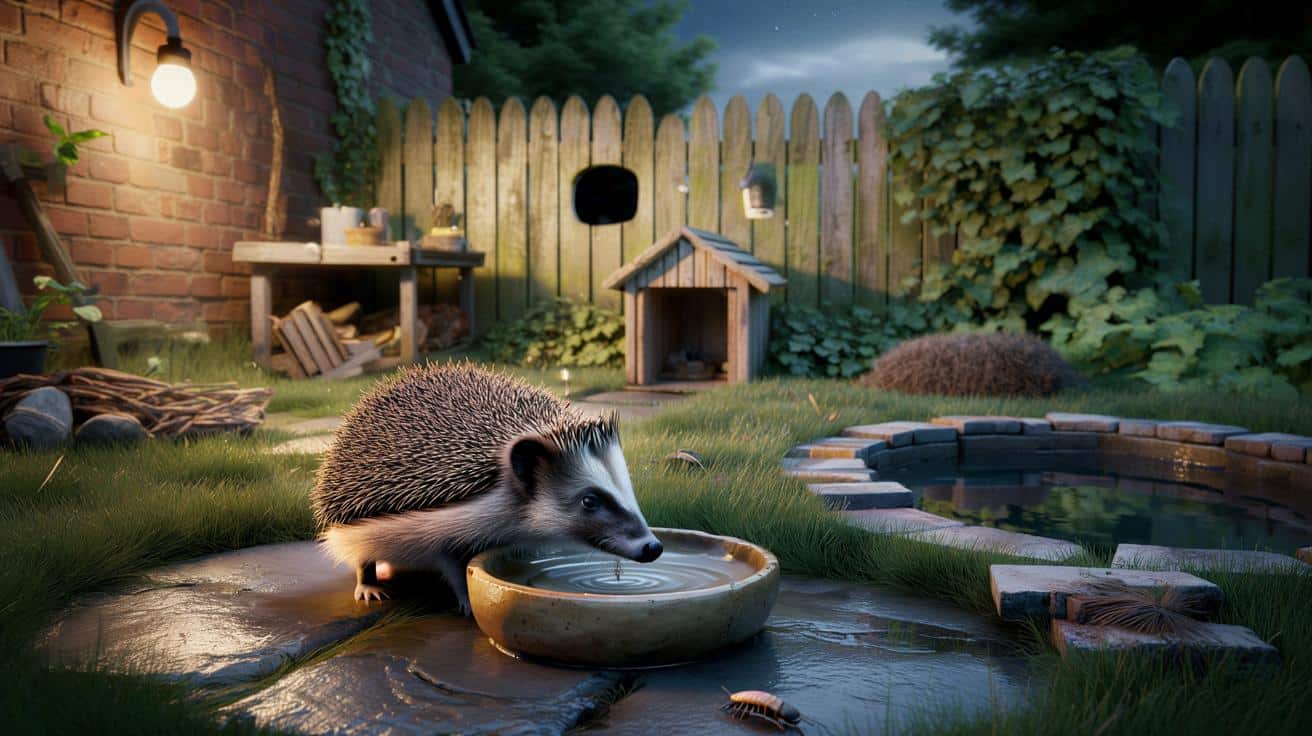Hedgehogs are vanishing from much of Britain, yet the comfiest refuge they crave is hiding in plain sight: our back gardens. Night after night they patrol for beetles and worms, crossing fences, patios and ponds in a quiet marathon. The fix isn’t a posh wildlife pond or a designer meadow. It’s small gaps, shallow dishes, and a kinder kind of mess.
Somewhere by the compost heap, a shape the size of a small loaf sighs through the leaves, pausing at a dish that wasn’t there last month. I try not to blink. We’ve all had that moment when a wild thing notices us back, and the garden feels bigger than its fences. Tonight, there’s a ripple in the ivy, a tiny grunt, and the faint click of spines settling as it shuffles on. One quick change altered the whole mood of this place. What else is hiding in plain sight?
The secret life at hedgehog height
Hedgehogs roam farther than most of us think, often a mile or more in a single night, tracing invisible highways beneath fences and along hedges. Your pristine lawn by itself is a green desert to them; they need cover, clutter and corners where insects thrive. The trick is to think like a creature that’s hungry, two inches tall, and slightly shy.
On our street in Leeds, a neighbour cut a neat square in the base of his fence, no bigger than a paperback. A week later, two gardens over, a trail camera caught a prickled silhouette hustling through at 11.43 pm, then again at 2.06 am, nose down like a tiny inspector. By the end of the month, three adjacent households had matching holes. The hedgehog’s loop grew from one patch into a network.
That’s the heart of it: connected spaces beat perfect spaces. A single garden can be cosy, but a chain of gardens becomes habitat, with food in one, shelter in another, water in a third. When you break the fence line with a safe gap and leave pockets of leaf litter to rustle with beetles, you stop asking a hedgehog to cross a car park and start offering it a lane.
Turn your patch into a hedgehog hotel
Start with a “hedgehog highway.” Cut a 13 cm by 13 cm square at the base of a fence or gate, then add the same on the other side with your neighbour’s blessing. Smooth any sharp edges and mark it discreetly so it doesn’t get blocked later. Add a shallow dish of water nearby and keep it topped up. **Fresh water only** changes everything in a dry spell.
Feed if you like, especially in spring and autumn. A handful of meaty cat biscuits or wet cat food in jelly, in a simple feeding station (an upturned storage box with a 13 cm doorway) keeps cats out and hedgehogs in. Skip milk – it upsets their stomachs – and go easy on mealworms and peanuts. Let’s be honest: nobody does that every day. If you miss a night, your visitor won’t hold it against you.
Build shelter the low-tech way. A log and leaf pile at the back of a border is luxury, and a wooden hedgehog house tucked against a fence, entrance facing east or north, is even better. Tuck dry leaves inside and around for insulation.
“Give me a hole to travel, a heap to hide, and a bowl to drink, and I’ll do the rest,” as every hedgehog-friendly guide might say.
- Hedgehog highway: 13 cm x 13 cm hole under the fence.
- Skip the slug pellets: let hedgehogs eat the slugs for you.
- Pond ladder: a brick slope or ramp so they can climb out.
- Wild corner: a square metre of leaf litter and logs.
- Routine check: lift nets, tidy string, scan before you strim.
Common slips to avoid and small wins to steal
Garden chemicals are a high price for a neat bed. Slug pellets and broad-spectrum sprays wipe out the hedgehog’s pantry and risk poisoning them directly. Ditch them and you’ll notice birds, beetles and soil life bounce back. No gadgets needed. Just patience and a new habit of leaving things be.
Ponds are brilliant when they’re hedgehog-safe. Low-sided is best, or add a ramp: a sturdy stick, a piece of rough wood, or bricks stacked in steps at one end. Netting, football goals and discarded string snag spines fast; lift them off the ground at night or store them away. Always check bonfires just before lighting, because a quiet log pile looks like a hotel to a sleepy hog.
Strimmers are another hidden risk. Walk the edges before you mow or trim, especially in long grass at fence lines. Give compost heaps a tap and a minute’s pause before turning. If you find a small hog out in daylight, thin, wobbly or fly-blown, that’s an emergency – contact your local rescue or the British Hedgehog Preservation Society for help. **Hedgehogs don’t need perfection. They need kindness that fits in the week.**
What happens when you leave room for wonder
A hedgehog-friendly garden isn’t a new hobby; it’s a shift in posture. You make a gap, move a dish, stack some branches, and your patch becomes part of a map no human drew. The nightly patrol returns. The lawn starts whispering at 10 pm and the cat pretends not to care. On a damp night, you hear crunches in the gravel and realise you’re hosting a very old story at hedgehog height.
It spills over. Kids start checking the water dish, the neighbour messages you a blurry photo at midnight, and someone leaves a box of cat biscuits on the doorstep. You notice moths on the patio light and beetle carapaces in the borders. The garden feels less like a project and more like a place. Something that hums without you.
You can make that first cut this weekend. It’s a small square, really. And it opens a whole world.
| Point clé | Détail | Intérêt pour le lecteur |
|---|---|---|
| Create a hedgehog highway | Cut a 13 cm x 13 cm hole at the base of fences to connect gardens | Makes your patch part of a larger, nightly route |
| Offer water and safe food | Shallow water dish, meaty cat food in a simple feeding station | Helps hedgehogs in dry spells and during hibernation prep |
| Build cover, avoid hazards | Leaf/log piles, hedgehog house, no pellets, pond ramp, check bonfires | Turns your garden into shelter instead of a risk zone |
FAQ :
- What should I feed visiting hedgehogs?Meaty cat or dog food (wet in jelly or dry biscuits) and fresh water. Avoid milk and keep mealworms/peanuts to a minimum.
- How big should the fence hole be?About 13 cm by 13 cm. That’s large enough for hedgehogs and too small for most pets.
- Can I still have a tidy garden?Yes. Keep your neat beds, but dedicate one quiet corner to leaves and logs. A little planned mess goes a long way.
- Are ponds safe for hedgehogs?They are with an escape route. Add a ramp or shallow beach so any animal can climb out.
- When do hedgehogs hibernate, and should I feed then?They typically hibernate late autumn to spring. Offer water year-round; food is most helpful in spring and autumn as they build or regain weight.









Love the “connected spaces beat perfect spaces” idea. We cut a 13cm square last weekend and—no joke—trail cam caught a hog at 11:41 pm. Fresh water dish was empty by morning. This was suprisingly easy.